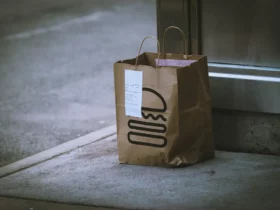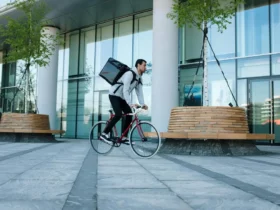Deciding between side hustles can be a real head-scratcher, especially when it comes to the giants of food delivery: DoorDash and Instacart. I’ve been there, weighing the pros and cons, and let me tell you, it’s not just about picking up orders and dashing to doorsteps.
In this article, I’ll dive into the nitty-gritty of DoorDash versus Instacart. We’ll look at everything from pay rates and driver requirements to the nuances of making deliveries and how gas usage could affect your earnings. Whether you’re looking to make some extra cash or considering a full-time gig, understanding these platforms is key.
So, buckle up! I’m about to break down the details that’ll help you decide which delivery service could be the better fit for your side hustle goals. Trust me, you won’t want to miss the insider scoop on these two.
Company Overviews and Core Services
What is DoorDash?
DoorDash, established in 2013, quickly rose to prominence as a leading on-demand food delivery service. It’s a platform that I often use for its convenience. Based in San Francisco, DoorDash was conceived by Stanford students looking to disrupt the food delivery industry. The company excels in offering meals from a vast array of restaurants and eateries to customers’ doorsteps.
As a big player in the food delivery space, DoorDash has an impressive reach, operating in over 7000 cities across North America, Australia, and Japan. In the US alone, it holds a staggering 60% market share. I find it fascinating that DoorDash collaborates with more than 340,000 restaurants and merchants, making it incredibly likely you’ll find your favorite food spots on the app.
In my experience, DoorDash has adeptly adapted to changing customer needs. Besides meals, DoorDash now provides Shop & Deliver services, which allows customers to order from grocery, convenience, and retail stores. Only the more experienced Dashers handle DoorDash Drive deliveries, which include catering and larger orders, indicating the company’s commitment to quality service.
Here’s a quick glance at key factors about DoorDash:
| Availability | Market Share | Partnerships |
|---|---|---|
| Over 7000 cities | Nearly 60% in the US | 340,000+ restaurants/merchants |
What is Instacart?
Instacart started the same year as DoorDash and rapidly became an immensely popular online grocery delivery company. It’s a game-changer for me when I can’t spare time for grocery shopping. With over 600,000 freelance shoppers and partnering with more than 85% of US grocers, which includes over 8000 stores, Instacart has made online grocery shopping a seamless experience.
What stands out to me about Instacart is the personal touch it adds to grocery shopping. Users like me can simply create a shopping list in the app and have a personal shopper pick out and deliver everything. From fresh produce to baked goods and even alcohol, there’s almost nothing you can’t place on your digital shopping list.
Another aspect that makes Instacart stand out is the potential for earners to make over $20 per hour, which is a significant draw for those looking to supplement their income. The balance between earning potential and the flexible schedule creates an attractive option for shoppers and delivery personnel.
Service Offerings and Delivery Options
DoorDash’s Range of Services
I’ve noticed that when it comes to variety, DoorDash really shines. Originally, their focus was on restaurant meal delivery, which remains their bread and butter. I can just place an order through the app, and a Dasher will bring it right to my doorstep. It’s this convenience that keeps them at the forefront of the food delivery game.
But they’ve expanded beyond that. Now, DoorDash offers a Shop & Deliver service for grocery, convenience, and retail stores. It’s a fantastic option when I need more than just a meal. For larger orders, such as catering, they have DoorDash Drive, although it’s designed for experienced Dashers. It’s encouraging to see that they’re not just resting on their laurels but are exploring ways to meet the ever-growing demand for quick and reliable home delivery.
Instacart’s Grocery Delivery Focus
On the flip side, Instacart has carved out a niche mainly in the online grocery sector. They partner with over 300 grocery stores, embodying a personal shopping experience through the app. It’s as simple as listing what I need, and a freelance shopper handpicks my items and delivers them.
Instacart truly excels in this space. It’s targeted at those who either can’t find the time or prefer not to go grocery shopping themselves. Whether it’s fresh produce or household essentials, their service is a lifesaver for busy individuals. And with over 600,000 shoppers, it’s evident they’re equipped to handle a high volume of orders. It’s about the ease of having everything from your shopping list brought straight to your kitchen counter.
Geographic Availability and Market Reach
DoorDash’s Coverage Areas
I’ve found that DoorDash’s coverage is quite extensive, expanding across the U.S., Canada, and even branching out into Japan and Australia. With operations in over 7000 cities worldwide, their geographic reach is impressive. It speaks volumes about their ambitions to dominate the food delivery sector globally and meet the demands of an ever-growing customer base looking for convenience in meal delivery. In the U.S. alone, DoorDash boasts a nearly 65% market share, solidifying their lead in the industry.
DoorDash’s strategy includes partnering with a multitude of restaurants and merchants – we’re talking more than 340,000 partners. That’s an incredible number that includes big names like Chick-fil-A and Wendy’s, as well as specialty and local dining establishments. Their approach ensures that wherever I am, there seems to be a DoorDash option available, be it for a quick lunch or when I’m looking to treat myself to something more upscale.
Instacart’s Service Locations
Moving on to Instacart, their main focus is on the online grocery delivery sphere. They’ve carved out a solid position by partnering with a wide range of grocery and retail chains. Names like ALDI, Costco, and Target are at the top of the list, which means I can get virtually anything I need from groceries to home goods. And while Instacart might be more secretive about the exact number of cities they service, their partnerships cover a huge percentage of U.S. grocers.
A quick zip code search on Instacart’s website is all it takes to find out if they’re active in a particular area, which I find really convenient. And although they might not yet have the same international presence as DoorDash, their focus on local grocery services is an essential niche. Instacart has become invaluable for those who either can’t get to the store or prefer the ease of having someone else do their shopping. This personalized approach has resonated well, with a network of over 600,000 freelance shoppers ready to handpick and deliver groceries at my doorstep.
Pricing Structure and Fees
Understanding DoorDash’s Pricing
When I’m considering using DoorDash, the pricing structure’s pretty straightforward, but there are a few things I keep an eye out for. Delivery fees fluctuate based on the restaurant, typically ranging from $5.99 to $8. Since these can vary, I always check the app’s checkout screen before confirming my order, which is handy to avoid any surprises. What’s more, there could be additional charges like a $2 fee for smaller orders and peak-hour pricing during busy times.
Then there’s something called DashPass, which changes the game for frequent users. For a monthly fee, subscribers wave goodbye to delivery fees on orders from eligible restaurants over $12 and enjoy reduced service fees. As a tip, tipping is optional, so when I’m satisfied with my service, I like to show my appreciation to the driver.
Instacart’s Pricing and Membership Fees
Instacart’s model is a bit different, focusing on grocery deliveries. For anyone placing their first order, it’s free, which scores points for convenience without the upfront cost. Afterwards, fees begin at $3.99 for orders over $35, with the potential for extra fees on same-day or small deliveries. I keep in mind the heavy order fee for anything over 50 pounds – it’s an additional one to watch out for.
Opting for Instacart Express, which costs $149 annually, makes sense if I’m planning to use the service regularly. It offers unlimited deliveries, which can really save money over time. Instacart keeps their pricing competitive with retail store deals, and the fact they accept coupons up to 40% off is a sweet deal.
Both services definitely cater to different needs but understanding their fees has helped me make smarter choices based on what I’m looking to get delivered.
User Experience and App Functionality
Navigating the DoorDash App
I’ve found that the DoorDash app is quite user-friendly, especially with the way it utilizes color-coded zones to signal demand. It takes the guesswork out of deciding where to begin. Whenever I open the app, red zones indicate hotspots where I can start dashing and earn money straight away. This real-time information is a lifesaver during rush hours. When I accept an order, everything I need is cleanly laid out on the screen: restaurant location, items I’m delivering, and the target drop-off time, which helps me manage my deliveries efficiently.
The app also facilitates a seamless navigation to the restaurant, and from there, to the customer’s location. I really appreciate that customers can specify their delivery preferences, including no-contact delivery, which has become increasingly important. It shows that DoorDash is attentive to both the current societal needs and personalized customer service. Not to mention, DoorDash’s immediate earnings display post-delivery provides a clear and transparent breakdown of my pay, including any potential tips.
Using the Instacart Platform
The Instacart platform operates a bit differently. When I start a shopping batch, I’m greeted with a list of available orders and all the expected details: earnings, items, the store, and the delivery distance.
This platform allows me to act as both shopper and delivery driver, which adds variety to my work. While shopping, the app requires me to scan barcodes or enter items manually, which can be time-consuming but ensures accuracy for the customer’s order.
When items are out of stock, I can communicate directly with customers for replacements or simply mark the item as unavailable, which automatically processes a refund. It’s a practical touch that maintains customer satisfaction.
Additionally, there are options for customers to request no contact delivery, just like DoorDash.
It’s fantastic to see this level of customization in the app, offering me guidance on how to handle each unique delivery.
After completing the order, I can expect to see my earnings promptly in the app, making the whole process straightforward and reliable.
For me, these in-app functionalities make the process of picking up and delivering groceries an efficient and profitable venture. Instacart’s focus on not just delivery, but also the shopping aspect, has certainly refined my multi-tasking skills and customer service prowess.
Every time I open the app, it’s clear that I’m entering a well-structured work environment that caters to the needs of its shoppers and the customers they serve.
Delivery Speed and Reliability
When choosing a delivery service, speed and reliability often rank high on buyers’ priority lists. Let’s break down how DoorDash and Instacart stack up in these areas.
DoorDash’s Delivery Times
I’ve found that DoorDash has been pushing the boundaries of quick delivery. Recently, the platform’s rapid-grocery-delivery experiments have led to 15-minute delivery services from DashMarts in specific urban areas like Manhattan and Brooklyn.
This move comes after observing similar ultrafast delivery startups scaling down, which signals DoorDash’s commitment to fast delivery services.
In more general terms, DoorDash operates typically until 11:00 pm or 12:00 am, depending on the location, catering to both lunch crowds (11:00 am – 2:00 pm) and dinner patrons (5:00 pm – 9:00 pm).
During these peak times, orders are flying in, and as a Dasher, I know I have to be quick to meet customer expectations. DoorDash claims to offer convenience and reliability, aiming for customer satisfaction with hot and prompt deliveries, especially when Dashers use their hot food bags to keep meals at the right temperature.
Instacart’s Same-Day Service
On the other side, Instacart specializes in same-day grocery service. As someone who appreciates fresh groceries, knowing that I can place an order and have it on my doorstep in the same time frame is impressive.
With a vast network of more than 300 partner grocery stores, Instacart prioritizes a seamless shopping experience, from selection to delivery.
For the busy folks, Instacart’s business model is a marvel. Shoppers are available for selection almost immediately after an order is placed, and the app’s tracking system allows customers to follow their order from the store to their door.
Plus, with in-app chat, any forgotten items can be communicated and added, enhancing the service’s reliability. It’s these touches that affirm Instacart’s prominent place in the quick and dependable same-day grocery delivery arena.
Customer Service and Support
Resolving Issues with DoorDash
When it comes to getting help as a DoorDash customer, I’ve found the service to be quite accessible. Should an issue arise, DoorDash makes it simple to reach out for support.
Their chat and call support are particularly handy, being available 24/7. It’s reassuring to know that whatever time of day or night I might need to get a delivery issue sorted out, help is just a phone call or a live chat away.
Beyond that, DoorDash also has an extensive online help center. I’ve often turned to it for quick answers to common questions, saving me the need to contact support directly. It’s a great first stop for information, and the articles are very straightforward.
I like that DoorDash recognizes the varying degrees of immediacy for different types of inquiries. If I just need a quick tip about the app or want to understand a fee, I can navigate the help center and find what I need without ever having to talk to someone. If it’s more urgent, though, I can jump straight into a chat session or make a call.
Instacart’s Customer Support Experience
Meanwhile, Instacart also steps up with a robust support structure. If I’m experiencing trouble, there are several ways I can reach out for assistance.
I can connect with an issue specialist by phone or email, or utilize the in-app chat support. The latter is a feature I rate highly because it facilitates real-time communication, which is crucial when I need a swift resolution.
One standout service that I find admirable about Instacart is their attention to Senior Support Service.
Senior customers have this dedicated line to help them navigate the app and service – a thoughtful addition that caters to customers who might not be as tech-savvy.
Tipping with Instacart is straightforward. It’s optional and not automatically included, which means I have the flexibility to show my appreciation for the shopper’s service as I see fit. This freedom of choice regarding tipping is something I believe enriches the customer experience and empowers shoppers to provide exemplary service.
Employment and Gig Opportunities
As someone who’s experienced the gig economy firsthand, I’ve noticed how it’s reshaped the way we think about jobs. It’s not just about the traditional nine-to-five anymore, it’s about flexibility and control over my work schedule.
Companies like DoorDash and Instacart have emerged as frontrunners in this new economy, offering distinct opportunities for those of us seeking employment that fits into our personal lives rather than the other way around. Let’s take a closer look at what it’s like to work for these two giants.
Working as a DoorDash Driver
DoorDash offers a simple proposition: deliver food and get paid. My experience has shown me that being a Dasher means having the autonomy to decide when and where I want to work. Flexibility is the main draw here—I can log into the app and start taking orders whenever it’s convenient for me. I’ve got friends who schedule their work a week in advance while others, like me, prefer to hop on during peak hours for the best-paying gigs.
I’ve learned that not all deliveries are equal though. Some orders are low-paying, which can be a downside. On the upside, DoorDash’s model rewards me for timely and longer-distance deliveries. Plus, receiving tips directly from customers can significantly boost my earnings, especially when I provide great service. The vehicle requirements are flexible too; I’ve seen Dashers on bikes, scooters, and even on foot in dense urban areas.
| DoorDash Driver Requirements | |
|---|---|
| Age | At least 18 years old |
| Driving Experience | Minimum 2 years |
| Background | Clean driving record and criminal history |
| Vehicle | Any reliable transportation |
| Tax Status | Independent contractor |
It’s a pretty straightforward setup, but let’s not forget the responsibilities like covering fuel and maintenance costs since Dashers are independent contractors.
The Instacart Shopper Experience
Working for Instacart, on the other hand, involves grocery shopping for others, which adds another layer to the delivery process. As a full-service Instacart shopper, I’m part shopper and part driver. The process starts with the app, which shows available batches—or orders—complete with estimated earnings and distance information.
A key part of the Instacart job is communication, I’ve found. If an item’s out of stock, I can message the customer directly through the app to find a suitable replacement. Efficiency is crucial since I’m paid per batch, and time is literally money here. There’s potential to earn more by taking on double batches, and during peak times, Instacart offers incentives that can ramp up the earnings.
Here’s what I need as a full-service Instacart shopper:
| Instacart Full-Service Shopper Requirements | |
|---|---|
| Age | At least 18 years old |
| Vehicle | Consistent access to a vehicle |
| Driving Experience | Minimum 2 years, clean record |
| Smartphone | Android 5.0/iOS 9.0 or later |
| Physical | Ability to lift 30 lbs |
With Instacart, I find that the earning potential is somewhat higher, especially when I work during busy periods or manage to efficiently complete larger orders. Similar to DoorDash, tips come directly from customers and can be quite substantial.
Both platforms provide us, the gig workers, with ample opportunities to earn money on our terms. It’s all about choosing the right fit for our lifestyles, balancing the demand for immediate delivery services against the freedoms and responsibilities inherent in gig work.
Special Features and Partnerships
When I compare DoorDash and Instacart, it’s fascinating to see how each platform tries to stand out by securing exclusive deals and forging strong partnerships. Below, I’ll delve into some unique offerings that each service brings to the table, enhancing the customer’s experience and contributing to their success in the competitive realm of delivery services.
Exclusive Deals and Partnerships with DoorDash
DoorDash isn’t just about food delivery; it’s also about giving customers access to a broad array of products that now extends into general retail. By the end of 2020, just a few years after its initial launch, DoorDash touted an impressive milestone with over 75,000 non-restaurant partnerships. That’s a number significant enough to show DoorDash’s commitment to growth beyond mere meal deliveries.
I’ve noticed companies ranging from big-box retailers to specialized stores aligning with DoorDash. Some of their notable partnerships include:
- Sephora: Reaching the beauty enthusiasts
- Big Lots: Providing bulk goods and home essentials
- PetSmart: Delivering pet supplies directly to animal lovers
- Dicks Sporting Goods: Catering to the fitness and outdoor crowd
- Target and Office Depot: Offering office supplies and household items conveniently at your doorstep
These partnerships not only expand the market reach for both DoorDash and its associates but also offer customers more variety and convenience.
Instacart’s Unique Offerings and Collaborations
Instacart, on the other hand, remains a key player when it comes to grocery delivery and has some distinctive collaborations as well. They focus predominantly on making grocery shopping more innovative and user-friendly.
Instacart’s approach to transforming grocery shopping with technology is particularly evident in their partnerships that aim to enhance the customer experience. They’ve placed a strong emphasis on ensuring that the future of grocery shopping is shaped by those who are integral to the industry.
While they have maintained a lower profile in media announcements regarding new partnerships, Instacart’s idea of innovation seems to be more about refining and perfecting the grocery delivery experience rather than expanding into other retail categories. Their strategy appears to center around investing in technology that enhances shopping efficiency and customer satisfaction.
Both DoorDash and Instacart understand the importance of exclusivity and strategic partnerships in staying ahead of the game. These alliances aren’t just about brand expansion; they’re essential in meeting evolving customer expectations and fostering long-term loyalty. Each company’s unique deals and collaborations pave the way for an intriguing competition in the delivery service battleground.
Choosing Between DoorDash and Instacart
Weighing the options between DoorDash and Instacart isn’t just about food delivery—it’s about choosing an experience that best fits my lifestyle.
Whether I’m looking for the convenience of a user-friendly app to order a meal or the flexibility to shop and deliver groceries myself, each service has its unique strengths.
DoorDash’s partnerships bring a variety of goods right to my doorstep, while Instacart’s focus on grocery innovation could be a game-changer for how I handle my weekly shopping list.
It’s clear that both companies are fiercely competitive, constantly evolving to meet my needs and exceed my expectations.
So, my decision ultimately boils down to the type of service I value most for my day-to-day life. And isn’t it great to have options?













